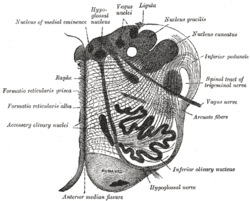Accessory cuneate nucleus
Appearance
| Accessory cuneate nucleus | |
|---|---|
 Section of the medulla oblongata at about the middle of the olive. (Accessory cuneate nucleus is not labeled, but cuneate nucleus is labeled at upper right, and the accessory cuneate nucleus would be found lateral to it.) | |
| Details | |
| Part of | Medulla oblongata |
| Identifiers | |
| Latin | nucleus cuneatus accessorius |
| NeuroNames | 768 |
| NeuroLex ID | birnlex_2634 |
| TA98 | A14.1.04.209 |
| TA2 | 6000 |
| FMA | 72603 |
| Anatomical terms of neuroanatomy | |
The accessory cuneate nucleus is located lateral to the cuneate nucleus in the medulla oblongata at the level of the sensory decussation (the crossing fibers of the posterior column/medial lemniscus tract).
It receives sensory input about position and movement (proprioception) from the upper limb by way of cervical spinal nerves and transmits that information to the cerebellum.[1]
These fibers are called cuneocerebellar (cuneate nucleus → cerebellum) fibers.
In this function, the accessory cuneate nucleus is the upper extremity equivalent of Clarke's column[1], also called the nucleus thoracicus, which is the source of spinocerebellar connections for proprioception from the lower limb.
Additional images
References
- ^ a b "Medical Neurosciences". Archived from the original on 2010-01-25.

